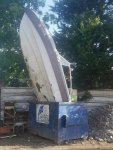Opened up the raw water pump on the front of my VP engine to check the impeller condition after an overheat event and accidentally dropped a stainless steel machine screw during the process. Of course, the screw bounced between the stringer and the plastic gas tank and is now rolling around beneath the gas tank. This is a small stainless steel machine screw with a round head (allen key) on it that is about 1" long.
Long story short, me and a helper sacrificed a boating vacation day trying everything under the sun to retrieve this screw and it appears that it just isn't coming out without removing the tank first. My fear is that this screw will eventually cause the fuel tank to leak - maybe never, maybe not while we own it, maybe 5 years from now, maybe next year - will we catch it in time if a leak occurs? Hate the idea of always looking over my shoulder for a gas leak that might happen (or not). Also, seems awful to hack up a boat to recover a screw due to a 1-2 second lapse from being extremely careful during a routine maintenance procedure, but that's the state of boat design & manufacturing practices, perhaps.
Took me years to find this boat, I kinda like it the way it is, and haven't had it a whole year yet so not ready to get rid of it yet. Also, not comfortable with sawing up the boat to get the fuel tank out either.
The tank sits isolated in a fiberglass box inside the boat (there is a drain hole, but not a clear path that would accommodate the screw to allow me to flush it out).
Would it be realistic to put some type of solution in the area where the plastic fuel tank sits (blocking the drain hole first, the solution would go into the fiberglass area and fill the gap between the fiberglass and the plastic tank deep enough to ensure the screw is covered) and then introduce some sort of dissimilar metal into the solution that would cause the stainless steel screw to dissolve through electrolysis? Could this be setup to accomplish total (or near total) dissolution in a matter of a week or two? a month? Can it be done with materials commonly available?
Curious to hear your thoughts.
Long story short, me and a helper sacrificed a boating vacation day trying everything under the sun to retrieve this screw and it appears that it just isn't coming out without removing the tank first. My fear is that this screw will eventually cause the fuel tank to leak - maybe never, maybe not while we own it, maybe 5 years from now, maybe next year - will we catch it in time if a leak occurs? Hate the idea of always looking over my shoulder for a gas leak that might happen (or not). Also, seems awful to hack up a boat to recover a screw due to a 1-2 second lapse from being extremely careful during a routine maintenance procedure, but that's the state of boat design & manufacturing practices, perhaps.
Took me years to find this boat, I kinda like it the way it is, and haven't had it a whole year yet so not ready to get rid of it yet. Also, not comfortable with sawing up the boat to get the fuel tank out either.
The tank sits isolated in a fiberglass box inside the boat (there is a drain hole, but not a clear path that would accommodate the screw to allow me to flush it out).
Would it be realistic to put some type of solution in the area where the plastic fuel tank sits (blocking the drain hole first, the solution would go into the fiberglass area and fill the gap between the fiberglass and the plastic tank deep enough to ensure the screw is covered) and then introduce some sort of dissimilar metal into the solution that would cause the stainless steel screw to dissolve through electrolysis? Could this be setup to accomplish total (or near total) dissolution in a matter of a week or two? a month? Can it be done with materials commonly available?
Curious to hear your thoughts.




















